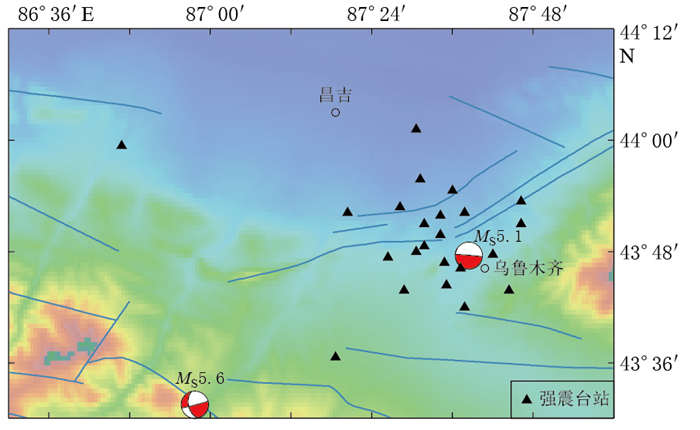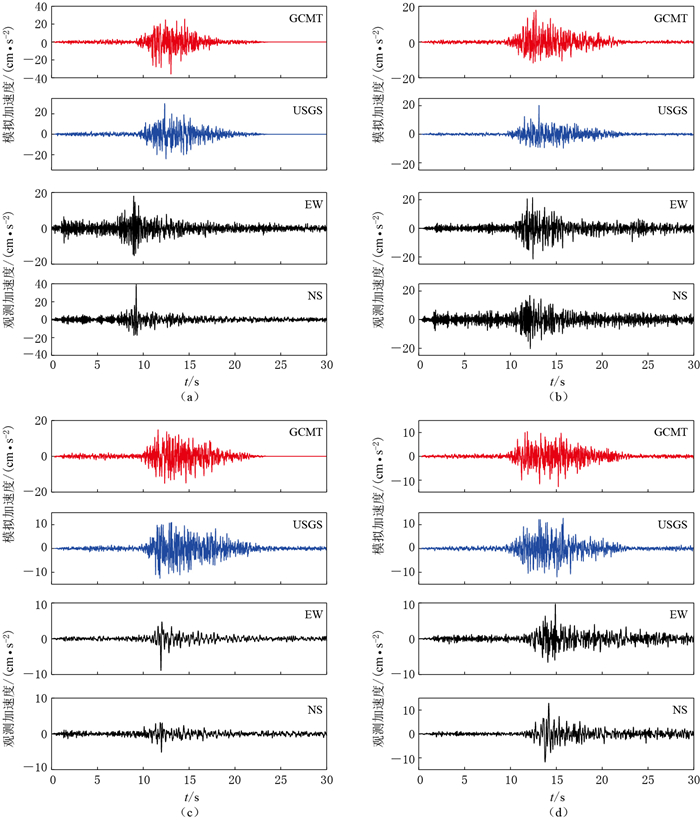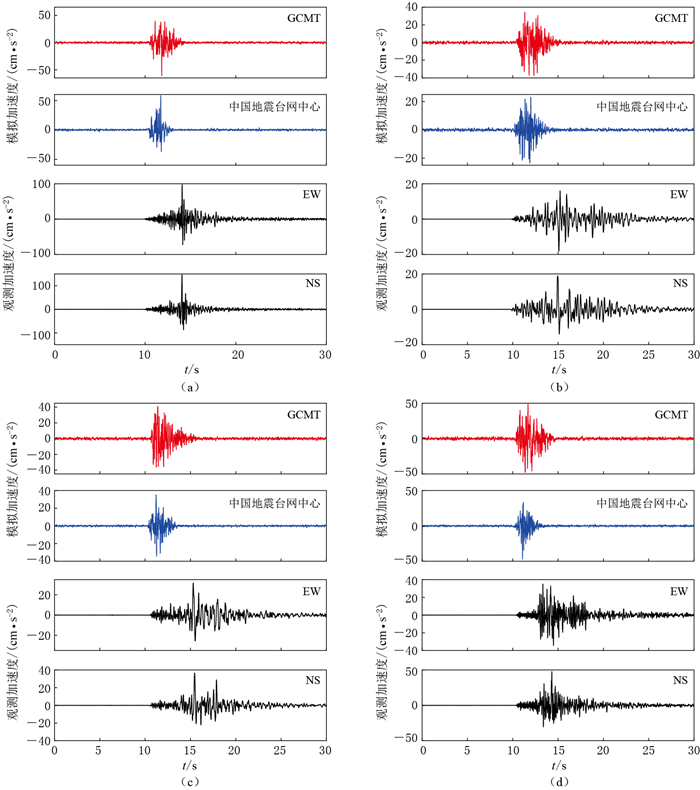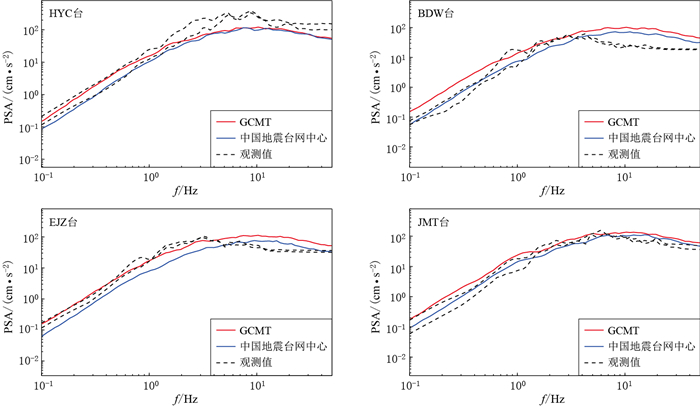Ground motion simulation of 2013 Vrümqi MS5.6 and MS5.1 earthquakes
-
摘要: 利用基于动力学拐角频率的随机有限断层法,针对2013年3月29日和8月30日乌鲁木齐发生的MS5.6和MS5.1两次地震,选择不同机构的震源参数对23个台站的45条强震记录进行强地震动模拟,对比分析加速度时程和反应谱,并计算模型偏差.通过与实际场点记录进行对比的结果显示:选取的不同机构震源参数模型得到的模拟加速度时程在持时和形状上与实际记录有一定差距,对于近震源的台站,模拟结果的峰值加速度(PGA)比观测结果小,对于稍远的台站,结果基本能够保持一致;而加速度反应谱,模拟结果与观测结果具有较好一致性; 随机有限断层模型的误差在±0.5以内,拟合效果较好,而且高频段的拟合效果要好于低频段;采用不同机构震源参数模型得到的模拟结果与观测结果得到的PGA分布特征较为一致,但模拟结果的峰值加速度要低于观测结果.
-
关键词:
- 随机有限断层法 /
- 强地震动模拟 /
- PGA分布 /
- 2013年乌鲁木齐两次地震
Abstract: In this study, we simulated strong ground motion of two earthquakes with MS5.6 and MS5.1 occurred in Xinjiang Vrümqi in 2013 based on modified stochastic finite fault modeling with dynamic corner frequency. 45 strong ground motion records from 23 stations were chosen to simulate by different source parameters, and response spectrum and accelerograms were compared with the observed ones. The results show that simulated strong ground motion have some differences with observed data in duration and shape, and the value of simulated peak ground acceleration (PGA) is less than observed in near-source. For acceleration response spectrum, the simulated result is consistent with observed. The bias of stochastic finite fault is between ±0.5 suggesting a good agreement for high frequency. For different source parameters model, the distribution characteristic of simulated PGAs are consistent with observed, but the simulated PGAs are less than observed ones. -
引言
地震动是造成工程结构破坏和倒塌的主要原因,也是造成一系列诸如砂土液化、地面破裂塌陷、山体崩塌和滑坡等地质灾害的外部条件.随着经济、社会的发展,地震造成的重大灾难越来越受到关注,对重大建筑体的抗震设防也逐渐成为工程地震领域的研究重点.强地震动研究的结果可以直接用于各类工程结构和生命线工程系统的抗震设计,为各种工程提供设防依据,在防震减灾工作中起到极其重要的作用.然而从现有的强震记录来看,近震源区的记录仍然十分缺乏,因此需要通过数值模拟方法来获得足够多的强震记录,进行科学的分析研究,为地震安评工作提供理论和数据基础.
强地面运动的数值模拟主要有确定性方法、随机性方法和混合方法3种方法.确定性方法是基于动力学表示定理将地震动表示为震源时间函数与格林函数的卷积,通过计算理论格林函数或经验格林函数来得到某一场点的地震动.计算理论格林函数往往采用三维有限差分或谱元法等有限元方法; 在进行数值模拟时,为了达到足够的精度,往往需要较大的计算量,而经验格林函数法则受小震记录的限制,不适于缺乏小震记录的场地.随机性方法是将地震学模型与随机振动模型结合在一起的半经验半理论方法,将加速度反应谱视作理论震源模型、场地效应与传播路径的卷积,通过时间域模拟得到加速度时程.混合方法是综合确定性方法和随机性方法的优点,分别在高频段和低频段进行模拟.
对于缺乏小震记录的近场强地面运动模拟,考虑到运算效率,往往采用随机性方法进行模拟计算. Boore (1983)在Hanks和McGuire (1981)的研究基础上,提出随机点源法,利用Brune (1970)的震源理论模型和随机振动理论,对地震动加速度时程和加速度反应谱进行了计算;Atkinson (1984)在此后给出了三段式几何衰减模型,进一步优化了随机点源法在远场中的应用;Beresnev和Atkinson (1998)用随机点源法结合有限断层模型,发展出随机有限断层法.该方法利用有限断层的方法将断层破裂面划分为若干子断层, 将子断层在场点产生的地震动响应考虑延时进行叠加,即得到整个断层面在该场点产生的地震动.由于该方法对子断层尺寸较为敏感,对断层的辐射能不进行约束,导致随着子断层个数的增加,辐射能也随之增加,故该方法不适用于中小地震的模拟. Motazedian和Atkinson (2005)对随机有限断层法作了进一步发展,提出了基于动力学拐角频率的随机有限断层模型,改进后的方法对破裂面积较大的强震也能进行很好的模拟;同时利用基于动力学拐角频率的震源谱,消除了原有方法对子断层尺寸的依赖性,减小了子断层尺寸对远场辐射能的影响,进一步扩展了随机有限断层方法的适用性.利用随机有限断层模型对强地面运动进行模拟已被广泛应用于地震动模拟研究:王俊等(2012)利用随机有限断层法模拟计算了1979年溧阳M6.0地震时江苏3个台站的地震动,给出了该地震的仪器烈度分布图;孙晓丹和陶夏新(2013)利用随机有限断层法对汶川MS8.0地震进行了地震动模拟,并给出了断层附近的峰值加速度(peak ground acceleration,简写为PGA)分布;Mittal和Kumar(2015)也利用该方法对印度北阿坎德邦与尼泊尔边界的MW5.4地震进行了有限断层模拟.
根据中国地震台网中心(2013a, b),北京时间2013年3月29日新疆乌鲁木齐市乌鲁木齐县与昌吉市交界处发生MS5.6地震,同年8月30日在乌鲁木齐市又发生MS5.1地震.根据中国地震局地球物理研究所(2013a,b)结果:MS5.6地震震中位于昌吉市与乌鲁木齐县交界的山区中,震中位置为(43.4°N,86.8°E),断裂类型为走滑断裂,发震构造位于依连哈比尔尕断裂,该断裂全长约330 km,走向为WNW,倾向为SW;MS5.1地震震中位于乌鲁木齐天山区,震中位置为(43.8°N,87.6°E),震源错断类型介于正断层型与逆冲型之间,发震断层为西山断裂组,西山断裂组沿乌鲁木齐河分布全长约37 km,由多条出露地表的断裂组成.两次地震虽然没有造成人员伤亡,但发震时间相隔较短,距离城市较近,特别是MS5.1地震发生在市区人群密集区,且震源深度较浅,对建筑物造成了一定程度的破坏.为了能在破坏性地震后,快速给出近场强地面运动姝分布图,本文将利用基于动力学拐角频率的随机有限断层方法,对两次地震动建立模型进行模拟研究,以期能为震后的抗震减灾工作提供初步的科学依据.
1. 地震动数据
乌鲁木齐位于北天山山前的新生褶邹带上,位于北天山山前逆冲构造中段与弧形逆冲构造东段的交会部位,其南北两侧分别为柴窝堡盆地与准噶尔盆地,中间为西山断隆,地震活动较频繁,1965年在乌鲁木齐东曾发生MS6.6地震(杨发义,1990; 沈军,宋和平,2008).新疆地震台网在乌鲁木齐市区及周边共布设约35个强震台站,仪器类型主要以GSMA-2400IP,GSR-18和ETNA型记录器为主.在2013年发生的两次MS>5.0地震中,强震台站共记录到强震记录70余条,其中最近强震台站记录的震中距约为1 km,本文选取23个强震台站(图 1)两个水平分量记录较好的地震动进行研究,共得到45条震中距在150 km以内的强震记录.强震记录分别经过零线校正和4阶巴特沃斯(Butterworth)滤波处理,滤波频段为0.25—25 Hz.
2. 随机有限断层模型
2.1 随机有限断层法
Boore(1983)将场点处的加速度反应谱表示为震源项、场地项与路径项的乘积:

(1) 式中,A(M0, R, f)为加速度反应谱,M0为地震矩,R为震源距,f为频率; G(f)为受频率f影响的场地项,主要包括场地对地震波的放大效应以及地震波在局部场地内的高频能量衰减,常用场地放大因子和高频滤波器来表示;P(R, f)表示传播路径上的几何扩散和滞弹性衰减,往往用与路径相关的能量损失和场地的品质因子来表示;S(M0, f)为震源项,这里采用Brune (1970)模型来表示:

(2) 式中,fc为拐角频率,C=RθφVFS/(4πρR0β3)为比例因子,其中:Rθφ为辐射花样,一般取0.55;V为计算两水平分量占总剪切波能量比例,一般取

根据Motazedian和Atkinson(2005)提出的基于动态拐角频率的随机有限断层模型,拐角频率fcij取决于时间t和子断层累积滑移面积NR,随着破裂传播,fc逐渐减小,定义第i, j个子断层上的动态拐角频率为

(3) 式中,N为子断层总数,Δσ为应力降.
为了平衡由于动态拐角频率减小而造成的高频辐射能减弱效应,引入一个标度因子H来确保辐射能守恒,使子断层的总辐射能量不随破裂扩大而改变,而是通过能量分布向低频转移来减弱子断层尺寸对模拟地震动和远场辐射能的影响(Motazedian,Atkinson,2005).标度因子表示为

(4) 为保证远场低频傅里叶谱的一致性,Boore(2009)使用子断层数和标度因子定义了一个滤波器函数P在低频部分进行修正:

(5) 利用标度因子来修正子断层的加速度谱,新的标度因子写为

(6) 则对于每个子断层,基于动力学拐角频率的震源谱模型表示为

(7) 这样,通过累加某一场点上各子断层产生的地震动响应,考虑各子断层到观测场点的延时,即可得到该场点处记录到的地震动

(8) 式中l和w分别为子断层在长度方向的个数.
2.2 模型参数
在利用随机有限断层方法进行地震动模拟时,需要确定其震源参数、断层参数、场地参数及传播路径参数.本文所研究的两次地震震源参数如表 1所示,分别利用不同研究机构的震源参数来进行模拟.发震断层的断层参数依照Wells和Coppersmith (1994)的统计结果进行确定,子断层尺寸均取为1 km×1 km.应力降根据Kanamori和Anderson(1975)关于破裂面积、应力降与地震矩之间的关系计算得到.对于MS5.6地震,GCMT和USGS两家机构给出的的矩震级分别为MW5.4和MW5.5,计算得到的应力降均为2.2 MPa,对应的断层长宽分别为6 km×5 km和7 km×6 km;对于MS5.1地震,GCMT和中国地震台网中心两家机构给出的的矩震级分别为MW5.3和MW5.0,计算得到的应力降分别为2.1 MPa和1.9 MPa,对应的断层长宽分别为5 km×5 km和4 km×4 km.传播路径的几何扩散往往简化为一个分段式连续函数形式,本文选用Atkinson和Boore (1995)建立的北美东部三段式几何扩散模型.传播路径上的滞弹性耗散一般使用表示非均匀性和非弹性性质的地下介质的品质因子来定义,赵翠萍等(2004)、唐兰兰和李志海(2011)与刘建明和李志海(2014)都曾对北天山地区地下介质的品质因子进行过研究,得到相近似的结论,本文采用刘建明和李志海(2014)利用S波反演得到的结果,取地下介质品质因子为465.2f0.53.由于无法确定地震初始破裂点的位置,故参照实际记录的PGA分布和烈度分布,对两次地震可能初始破裂位置进行选取,分别选取单侧破裂和中心破裂两种模式进行模拟,然后对计算结果进行几何平均.
表 1 2013年乌鲁木齐MS5.6和MS5.1两次地震的震源参数Table 1. Source parameters of two earthquakes with MS5.6 and MS5.1 occurred in Vrümqi Xinjiang, in 2013发震日期 MW 震中位置 震源深度/km 节面Ⅰ 节面Ⅱ 参数来源 东经/° 北纬/° 走向/° 倾向/° 滑动角/° 走向/° 倾向/° 滑动角/° 03-29 5.4 86.96 43.52 38.5 167 51 -177 75 88 39 GCMT (2013) 03-29 5.5 86.85 43.46 34.0 256 88 45 164 45 177 USGS(2013a, b) 08-30 5.3 87.64 43.79 15.3 122 3 117 275 87 88 GCMT (2013) 08-30 5.0 87.64 43.76 12.0 81 88 -54 174 36 -176 中国地震台网中心(2013b) 场地条件对地震动具有重要影响,场地放大因子影响地震动幅值的大小,高频衰减影响高频端能量的强弱.本文中使用Atkinson和Boore (2006)给出的基岩场地和土层场地的放大函数,局部场地高频衰减由Anderson和Hough (1984)提出的高频衰减滤波器来表示,其中高频衰减系数κ是由场地和距离决定的参数,控制地震动的高频衰减,描述了地震波在地壳中的能量耗散对波长影响. κ取值越大,说明高频能量衰减越多,场地的高频吸收性越强;通常情况下,在场地岩石硬度越小的地区,κ值越大.为计算研究区域内的κ值,选取了2010年至2015年研究区内23个强震台站记录到的62条强震记录来进行计算(图 2).利用Anderson和Hough (1984)对κ的定义,将强震记录经过零线校正和滤波后,在半对数坐标中计算S波的傅里叶谱,选择其高频衰减的起始频率和终止频率进行计算,将各个台站的计算结果通过一阶近似得到0 km处的κ值,即为目标场地与传播路径无关的κ值.通过计算得到NS和EW两分向的κ与距离R之间的关系为κNS=0.02743+0.00002471R,κEW=0.02728+0.00002452R,平均后得到研究区域内的高频衰减系数κ为0.0274.
3. 地震动模拟结果
由于2013年3月29日乌鲁木齐MS5.6地震的实际地震动记录大多位于震中的东北方向,因此按照震中距的远近,只选取实际地震动记录较好的4个台站(图 3),将模拟结果与观测结果进行对比.分别利用两组来自不同机构的震源参数对该地震进行模拟,得到加速度模拟时程结果和加速度反应谱(pseudo acceleration response-spectra,简写为PSA)值,并与实际记录值进行对比,结果分别如图 4和图 5所示.由图 4可看出,两组加速度时程模拟结果较为接近,这主要是因为两组震源参数的地震矩和应力降值基本一致,断层的方位也基本相似;与实际记录相比,模拟结果在持时和形状上具有一定差距,但是PGA基本接近,原因是随机有限断层法是使用窗函数约束时程的形状,并采用简化的理论持时来得到时程的,所以不能很好地描述复杂的地震波传播过程.从图 5中的加速度反应谱对比来看,模拟结果与实际记录结果比较接近,整体一致性较好.
2013年8月30日乌鲁木齐MS5.1地震的震源错断类型介于正断层与逆冲断层之间,考虑近断层影响因素,分别在其断层走向两侧选取实际记录较好的4个台站,将模拟结果与观测结果进行对比,选取的4个台站分布如图 6所示.利用GCMT和中国地震台网中心两组不同震源结果对此次地震进行模拟,得到两组地震动加速度时程和拟加速度反应谱,并与实际地震动记录进行对比,结果如图 7和图 8所示,由于两组震源参数具有一定差别,尤其是对随机有限断层法影响较大的应力降值,从GCMT得到的值要比中国地震台网中心大,因此地震动加速度时程和PSA的模拟结果也较大.对于震中距较小的HYC台站,模拟PGA与实际PGA有较大差距,这可能与MS5.1地震的震源破裂类型有关,且对于近场地震动的上盘效应,随机有限断层法并不能很好地反映出来.所选4个台站的震中距都在15 km以内,由统计关系得到的理论路径持时与真实地震动传播路径持时具有较大差别,在持时和形状上差别都很大,这也是利用随机有限断层法模拟近场地震动的局限所在.从模拟的PSA来看,与实际记录值都比较接近.
根据Motazedian和Atkinson(2005)给出的方法,将随机有限断层模型的误差定义为模拟PSA和观测PSA的对数差:

(9) 标准差定义为

(10) 两次地震模拟模型的误差和标准差如图 9所示,其中实线表示为平均差,灰度为标准偏差.可以看出,高频段部分的拟合效果要好于低频段,3月29日MS5.6地震的两个模拟结果较为接近,误差基本相同;而对于8月30日MS5.1地震,利用中国地震台网中心震源参数进行模拟得到的结果误差(蓝色实线)较小,模拟结果要好于利用GCMT震源参数得到的结果.
4. PGA分布对比
PGA是描述地震动强度的重要参数,是估算地震烈度的参数之一,与建筑物的破坏有很高的相关性. 8月30日MS5.1地震震中位于乌鲁木齐市区,周边台站布设较多,基本上能将震源包络其中.本文对15个场点利用随机有限断层法进行模拟计算,得到PGA如图 10所示.从GCMT震源参数得到的PGA分布(图 10b)和中国地震台网震源参数得到的PGA分布(图 10c)同实际记录分布(图 10a)较为一致,表现为单侧破裂模式,主要沿东南向传播,破裂方向对PGA的影响较大,对背离破裂方向的场点,PGA显现快速衰减趋势;从PGA分布方向看,中国地震台网的断层解更接近于实际破裂过程.从图 10a可以看出,高PGA区主要集中在HYC和SGZ两个场点附近,模拟结果得到的PGA要低于观测的PGA.场点HYC记录到的PGA为143.7 cm/s2,两个模拟结果分别为61.1 cm/s2和58.3 cm/s2; 场点SGZ记录到的PGA为77.5 cm/s2,而模拟值分别为61.3 cm/s2和52.9 cm/s2,因为GCMT震源参数中的地震矩较大,因此PGA值要更大;但在震中距较小的场点,两个模拟结果与实际值的差别都较大,这与近场地震动的上盘效应和方向性效应两因素有关.
5. 讨论与结论
本文基于动态拐角频率随机有限断层方法,分别利用不同机构的震源参数建立有限断层模型,对2013年乌鲁木齐市区及其附近两次MS>5.0地震进行地震动模拟,得到了23个台站的加速度时程曲线和反应谱.通过与实际场点的记录进行对比,不同震源参数模型得到的模拟加速度时程在持时上与实际记录还是有一定差距,距离稍远的台站,模拟PGA结果与实际PGA结果基本能够保持一致,但在离震中较近的场点,模拟PGA结果与实际PGA结果就有较大差距;对于PSA,模拟结果与观测结果一致性较好.从模型误差数据上看,高频段模拟的误差要小于低频段的误差.从震源参数来看,震中位置对模拟结果影响并不大,主要影响参数是矩震级和应力降,应力降越大,模拟结果的峰值就越大. MS5.1地震的PGA分布结果显示,PGA主要沿东南向传播,表现为单侧破裂模式,破裂方向对PGA的影响较大,两次地震模拟结果的PGA分布特征与实际记录的较为一致,在近断层区模拟结果的值要低于观测结果;从分布方向看,中国地震台网中心的断层解更接近实际破裂过程.
对于乌鲁木齐这种中强震频发而强震观测资料并不丰富的地区,使用随机有限断层方法进行地震动模拟是较为可靠的方法.通过强震动模拟方法得到的结果,可以实现PGA或烈度的快速模拟,对进行灾情判定和震后救援具有一定的指导意义.模拟结果虽然在大部分台站都与观测结果较为接近,但仍在少部分台站有较大偏差,其原因主要是采用了大量的经验公式以及受场地条件的影响,下一步工作将利用最多的观测数据,建立更完善的模型来实现对强地震运动的准确预测.
-
表 1 2013年乌鲁木齐MS5.6和MS5.1两次地震的震源参数
Table 1 Source parameters of two earthquakes with MS5.6 and MS5.1 occurred in Vrümqi Xinjiang, in 2013
发震日期 MW 震中位置 震源深度/km 节面Ⅰ 节面Ⅱ 参数来源 东经/° 北纬/° 走向/° 倾向/° 滑动角/° 走向/° 倾向/° 滑动角/° 03-29 5.4 86.96 43.52 38.5 167 51 -177 75 88 39 GCMT (2013) 03-29 5.5 86.85 43.46 34.0 256 88 45 164 45 177 USGS(2013a, b) 08-30 5.3 87.64 43.79 15.3 122 3 117 275 87 88 GCMT (2013) 08-30 5.0 87.64 43.76 12.0 81 88 -54 174 36 -176 中国地震台网中心(2013b) -
刘建明, 李志海. 2014.新疆北天山非弹性衰减、场地响应及其震源参数研究[J].地震, 34(1): 77-86. http://d.wanfangdata.com.cn/Periodical/diz201401009 Liu J M, Li Z H. 2014. Non-elastic attenuation, site response and source parameters in the northern Tianshan Mountain, Xinjiang of China[J]. Earthquake, 34(4): 77-86 (in Chinese). http://d.wanfangdata.com.cn/Periodical/diz201401009
沈军, 宋和平. 2008.乌鲁木齐城市活断层探测与地震危险性评价主要成果简介[J].地震地质, 30(1): 273-288. http://d.wanfangdata.com.cn/Periodical/dzdz200801020 Shen J, Song H P. 2008. Brief introduction on the predominant results of the active fault detecting and seismic risk assessment in Urumqi city[J]. Seismology and Geology, 30(1): 273-288 (in Chinese). http://d.wanfangdata.com.cn/Periodical/dzdz200801020
孙晓丹, 陶夏新. 2013.基于动力学拐角频率的汶川主震近场地震动随机合成[J].土木工程学报, 46(增刊2): 124-129. http://d.wanfangdata.com.cn/Conference/7986621 Sun X D, Tao X X. 2013. Stochastic modelling of ground motions for the Wenchuan earthquake using dynamic corner frequency[J]. China Civil Engineering Journal, 46(S2): 124-129 (in Chinese). http://d.wanfangdata.com.cn/Conference/7986621
唐兰兰, 李志海. 2011.新疆天山中东段地区地震波衰减、场地响应及震源参数研究[J].地震学报, 33(2): 134-142. http://www.dzxb.org/Magazine/Show?id=27631 Tang L L, Li Z H. 2011. Ground motion attenuation, site response and source parameters of earthquakes in middle and eastern range of Tianshan mountain, Xinjiang of China[J]. Acta Seismologica Sinica, 33(2): 134-142 (in Chinese). http://www.dzxb.org/Magazine/Show?id=27631
王俊, 霍祝青, 詹小艳, 宋浩, 江昊琳, 徐戈. 2012.基于随机有限断层法的地震烈度计算研究[J].地震研究, 35(3): 374-380. http://d.wanfangdata.com.cn/Periodical/dzyj201203013 Wang J, Huo Z Q, Zhan X Y, Song H, Jiang H L, Xu G. 2012. Computational research on the seismic intensity based on stochastic finite faults method[J]. Journal of Seismological Research, 35(3): 374-380 (in Chinese). http://d.wanfangdata.com.cn/Periodical/dzyj201203013
杨发义. 1990.乌鲁木齐地质构造与地震活动[J].新疆师范大学学报:自然科学版, (2): 84-89. http://d.wanfangdata.com.cn/Periodical/xbdzxb201102006 Yang F Y. 1990. The geologic structure and earthquake movement in the area of Urumuqi[J]. Journal of Xinjiang Normal University: Natural Sciences Edition, (2): 84-89 (in Chinese). http://d.wanfangdata.com.cn/Periodical/xbdzxb201102006
赵翠萍, 张智强, 夏爱国, 刘杰. 2004.利用数字地震波资料研究新疆天山中东段地区的介质衰减特征[J].防灾减灾工程学报, 24(3): 300-305. http://d.wanfangdata.com.cn/Periodical/dzxk200403014 Zhao C P, Zhang Z Q, Xia A G, Liu J. 2004. Study of attenuation characteristics of the central and eastern Tianshan, Xinjiang using digital seismic waves[J]. Journal of Disaster Prevention and Mitigation Engineering, 24(3): 300-305 (in Chinese). http://d.wanfangdata.com.cn/Periodical/dzxk200403014
中国地震局地球物理研究所. 2013a. 2013年3月29日新疆维吾尔自治区昌吉回族自治州昌吉市、乌鲁木齐市乌鲁木齐县交界5. 6级地震[EB/OL]. [2017-09-07]. http://www.cea-igp.ac.cn/tpxw/266669.html. Institute of Geophysics, China Earthquake Administration. 2013a. Xinjiang Urumqi-Changji, MS5.6, earthquake on March 29, 2013[EB/OL]. [2017-09-07]. http://www.cea-igp.ac.cn/tpxw/266669.html (in Chinese).
中国地震局地球物理研究所. 2013b. 2013年8月30日新疆维吾尔自治区乌鲁木齐市5. 1级地震[EB/OL]. [2017-09-07]. http://www.cea-igp.ac.cn/tpxw/267551.html. Institute of Geophysics, China Earthquake Administration. 2013b. Xinjiang Urumqi, MS5.1, earthquake on August 30, 2013[EB/OL]. [2017-09-07]. http://www.cea-igp.ac.cn/tpxw/267551.html (in Chinese).
中国地震台网中心. 2013a. 新疆维吾尔自治区昌吉回族自治州昌吉市、乌鲁木齐市乌鲁木齐县交界5. 6级地震[EB/OL]. [2017-09-07]. http://news.ceic.ac.cn/CC20130329130110.html. China Earthquake Networks Center. 2013a. Xinjiang Urumqi-Changji MS5.6 earthquake[EB/OL]. [2017-09-07]. http://news.ceic.ac.cn/CC20130329130110.html (in Chinese).
中国地震台网中心. 2013b. 新疆维吾尔自治区乌鲁木齐市5. 1级地震[EB/OL]. [2017-09-07]. http://news.ceic.ac.cn/CC20130830132730.html. China Earthquake Networks Center. 2013b. Xinjiang Urumqi MS5.1 earthquake[EB/OL]. [2017-09-07]. http://news.ceic.ac.cn/CC20130830132730.html (in Chinese).
Anderson J G, Hough S E. 1984. A model for the shape of the fourier amplitude spectrum of acceleration at high frequencies[J]. Bull Seismol Soc Am, 74(5): 1969-1993. http://www.bssaonline.org/content/74/5/1969.short
Atkinson G M. 1984. Attenuation of strong ground motion in Canada from a random vibrations approach[J]. Bull Seismol Soc Am, 74(6): 2629-2653. http://www.bssaonline.org/content/74/6/2629.short
Atkinson G M, Boore D M. 1995. New ground motion relations for eastern North America[J]. Bull Seismol Soc Am, 85(1): 17-30. http://www.bssaonline.org/content/85/1/17.short
Atkinson G M, Boore D M. 2006. Earthquake ground-motion prediction equations for eastern North America[J]. Bull Seismol Soc Am, 96(6): 2181-2205. doi: 10.1785/0120050245
Beresnev I A, Atkinson G M. 1998. FINSIM: A FORTRAN program for simulating stochastic acceleration time histories from finite faults[J]. Seismol Res Lett, 69(1): 27-32. doi: 10.1785/gssrl.69.1.27
Boore D M. 1983. Stochastic simulation of high-frequency ground motions based on seismological models of the radiated spectra[J]. Bull Seismol Soc Am, 73(6): 1865-1894. http://www.oalib.com/references/13611287
Boore D M. 2009. Comparing stochastic point-source and finite-source ground-motion simulations: SMSIM and EXSIM[J]. Bull Seismol Soc Am, 99(6): 3202-3216. doi: 10.1785/0120090056
Brune J N. 1970. Tectonic stress and the spectra of seismic shear waves from earthquakes[J]. J Geophys Res, 75(26): 4997-5009. doi: 10.1029/JB075i026p04997
GCMT. 2013. Global CMT Catalog[EB/OL]. [2017-09-07]. http://www.globalcmt.org/cgi-bin/globalcmt-cgi-bin/CMT4/form?itype=ymd&yr=2013&mo=3&day=29&otype=ymd&oyr=2013&omo=8&oday=30&jyr=1976&jday=1&ojyr=1976&ojday=1&nday=1&lmw=5&umw=10&lms=0&ums=10&lmb=0&umb=10&llat=43&ulat=45&llon=86&ulon=88&lhd=0&uhd=1000<s=-9999&uts=9999&lpe1=0&upe1=90&lpe2=0&upe2=90&list=0.
Hanks T C, McGuire R K. 1981. The character of high-frequency strong ground motion[J]. Bull Seismol Soc Am, 71(6): 2071-2095. http://www.bssaonline.org/content/71/6/2071.short
Kanamori H, Anderson D L. 1975. Theoretical basis of some empirical relations in seismology[J]. Bull Seismol Soc Am, 65(5): 1073-1095. http://www.bssaonline.org/content/65/5/1073.short
Mittal H, Kumar A. 2015. Stochastic finite-fault modeling of MW5.4 earthquake along Uttarakhand-Nepal border[J]. Nat Hazards, 75(2): 1145-1166. doi: 10.1007/s11069-014-1367-1
Motazedian D, Atkinson G M. 2005. Stochastic finite-fault modeling based on a dynamic corner frequency[J]. Bull Seismol Soc Am, 95(3): 995-1010. doi: 10.1785/0120030207
USGS. 2013a. M5.2-70 km SW of Diwopu, China[EB/OL]. [2017-09-07]. https://earthquake.usgs.gov/earthquakes/eventpage/usb000fvfx#executive.
USGS. 2013b. M5.6-1 km WNW of Benzilan, China[EB/OL]. [2017-09-07]. https://earthquake.usgs.gov/earthquakes/eventpage/usb000je5n#executive.
Wells D L, Coppersmith K J. 1994. New empirical relationships among magnitude, rupture length, rupture width, rupture area, and surface displacement[J]. Bull Seismol Soc Am, 84(4): 974-1002. http://www.academia.edu/1151208/New_Empirical_Relationships_among_Magnitude_Rupture_Length_Rupture_Width_Rupture_Area_and_Surface_Displacement
-
期刊类型引用(5)
1. 刘中宪,周健,李程程,孟思博. 基于修正随机有限断层法的沉积盆地地震动模拟. 防灾减灾工程学报. 2023(05): 999-1008 .  百度学术
百度学术
2. 巴振宁,赵靖轩,吴孟桃,梁建文. 基于CPU-GPU异构并行的复杂场地近断层地震动谱元法模拟. 地震学报. 2022(01): 182-193 .  本站查看
本站查看
3. 何欣娟,潘华. 2021年云南漾濞M_S6.4地震的强地面运动模拟. 地震地质. 2021(04): 920-935 .  百度学术
百度学术
4. 谢旭,黄文彤,冀龙飞,王天佳. 断层破裂过程对减隔震桥梁地震反应的影响. 浙江大学学报(工学版). 2021(12): 2225-2233 .  百度学术
百度学术
5. 张冬锋,付长华,吕红山,俞瑞芳. 随机有限断层法及其工程应用中的问题分析. 震灾防御技术. 2018(04): 784-800 .  百度学术
百度学术
其他类型引用(6)





 下载:
下载:









